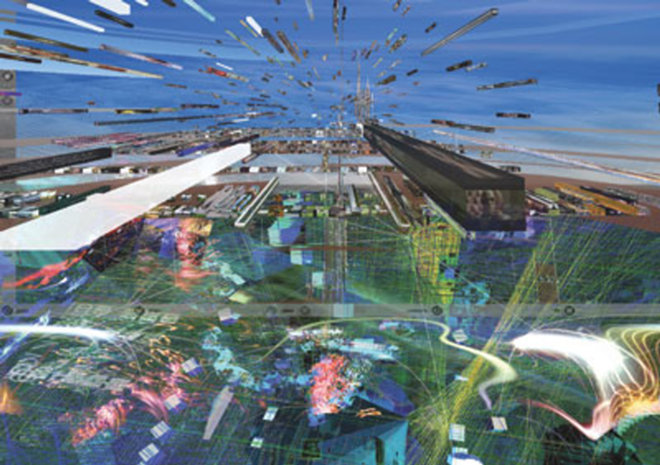
If you thought YouTube was already an immersive environment — a black hole for corporate productivity — just wait until you get a load of James Tunick and Janis Garancs's version.
In their 3-D virtual display, YouTube videos make up a landscape of floating towers hovering above a Martian baked-Earth surface. The taller the tower, the more popular the video, and viewers can navigate through this digital city with a joystick and 3-D glasses. Keep an eye peeled for your favorite second-screen celebrities; even LonelyGirl15, who recently inked a Neutrogena promotional deal, is here.
Granted, you can't actually watch the YouTube videos — just careen through an array of representative freeze-frames — but above and beyond the "whoa, dude" factor (which is pretty high), the project illustrates a practical principle: The pleasure of navigation largely determines information's usefulness. Inspired by watching Tom Cruise call up video clips and government records with mime-like gestures in Minority Report, Tunick and Garancs set out to propose an informational environment that is physically engaging, intuitive and just plain fun.
Their piece, "Parallel Cityscapes," takes center stage at StereoVision, USF CAM's historical and aesthetic exploration of perceptual experiments in art. From holograms to illusionary tricks, the works in this show often bridge the gap between popular and fine arts, not to mention art and science.
A local collector's passion for stereoscopy, which creates the illusion of three dimensions by presenting two separate images to the eyes through a special viewer, inspired the show. The collection of Dr. Robert Drapkin, a Pinellas-based oncologist, includes more than 8,000 examples of 19th-century photography, a fraction of which deal with stereoscopy; he frequently lends prints and objects to institutions in the Bay area and beyond. At the museum's entrance, cases of his antique stereoscopic viewers, from elaborate wooden cabinets to handheld models, display examples of the technology. (Most covetable: a sleek, black Bakelite View-Master from the 1940s, complete with round image reels. Oh yeah.)
CAM curator Izabel Galliera, who worked extensively with Drapkin's collection before joining the museum last September, makes her curatorial debut with StereoVision, and the graduate of USF's masters degree program in art history does credit to her alma mater. I only found myself wishing the show were bigger, with more examples of its imaginative-yet-rigorous premise. Not since Will Boys Be Boys? at Largo's Gulf Coast Museum of Art has a local museum exhibit delivered an intriguing contemporary premise with as much spirited energy.
Don't let Tunick and Garancs's eye-candy experience distract you from the more modest gems on display. Chuck Close's eerie holographic self-portraits put an unusual spin on his iconic approach to portraiture. The sight of an unruly, overgrown eyebrow accents the unsettling intimacy of beholding the artist's face in three dimensions, blue and green. Barbara Probst, who often uses a remote control to trigger cameras shooting the same scene simultaneously from different angles, has just two pictures in this show. The pair reveals (as her series of three or more images often do) different, even contradictory, visions of a single, staged event.
Relatively low-tech approaches to manipulating the viewer's experience of space pop up several times. Ian Burns's grainy video of the moon's surface includes everything but a spacewalking Neil Armstrong. Once you divine the source of its extraterrestrial transmission, the piece packs the best punch line in the show. An unusual, three-dimensional trompe-l'oeil by Leandro Erlich creates the illusion of a receding hallway leading into a gallery wall. Standing in front of the piece with crossed eyes while leaning back and forth seems to help. As with many of the pieces, you will need to engage interactively.
Contemporary stereoscopic viewers by Peter Bahouth entice viewers to step up to their elegant gold-rimmed lenses and sleek white housing; the artist's vivid color photographs await inside. If Jonathan Ives designed a minimal, streamlined stereoscope to match the iPod, it would look something like this. Janet Cardiff's video of a house on fire imparts the uncomfortable sensation of heat just by amplifying the sound of the crackling conflagration.
If Zilvinas Kempinas's four-channel video documenting a bike messenger's perilous journey through Manhattan doesn't make you feel like hurling, turn around. The front view isn't too bad, but the dizzying side angle shots of storefronts and aggressive traffic whizzing by — forget about whirling around to catch glimpses of all four screens in the gallery — make the head spin. On a lighter note, Kempinas's un-romanticized vision of New York experienced at 15 miles per hour on bumpy, pothole-ridden avenues struck me as the most true-to-life representation of life in the city I've ever seen, literally and metaphorically.
A hand-drawn animation by William Kentridge — the third of his videos currently on view in the Bay area (the others are at the Tampa Museum of Art until July 8) — offers a psychological interpretation of double vision as protagonist Soho Eckstein's disintegrating personality.
Finally, one of my favorite pieces in the exhibit depicts artist Juan Céspedes as a white-body-suit-clad gimp trapped inside a television set. As Céspedes enacts a tongue-in-cheek performance in his cramped quarters, placing a pixilated green channel number and volume bar against the screen, the viewer experiences with unsettling ease the sensation that the artist is actually physically present. Céspedes feels live inside the TV's space (or, rather, TV-space in the broader sense), though I can fairly promise you that if you tap on the screen to get his attention, he won't tap back.
If StereoVision — particularly its antique components — whets your appetite for a bigger glimpse of the Drapkin Collection, you won't have to wait long. Later this year, Drapkin will release a book based on the collection, though a mere 300 of his 8,000 prints and objects will be reproduced inside. Essays on themes and technology in 19th-century photography by Galliera, Gainesville curator Tom Southall and curators from St. Pete's Museum of Fine Arts (which has one of the strongest photography collections in the Southeast) will comprise the volume.
















